WARNING For J-Bax and other compasionate vegetarians  – this post might not be for you.
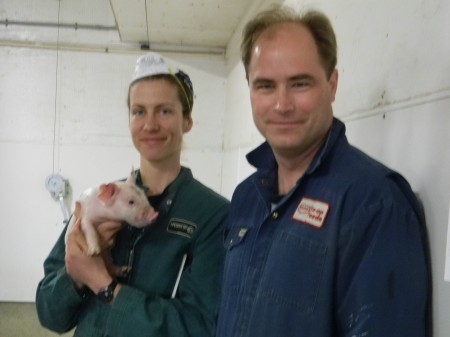
Wednesday I went to a pig farm to round out my tours of Saskatchewan agriculture.  This is quite a lot different than the 15 neighbor pigs on our property when I was a kid, the  pink and black breeding pair that I used to feed compost and scratch with a stick (I wasn’t allowed in the sty because my mom was afraid I would get gored by the tusks). Nothing about my trip today was like Charlotte’s web. Modern pork production is intensive factory farming: 300-2000 sows per facility with intensive biosecruity and highly structured feeding and medical protocols.  In order to visit the pig farm, I needed to abstain from visiting any barns/animals for 60 hours, to leave all my clothes in a locker, take a shower with anti-bac soap, put on clean barn clothes and boots.  No cameras, notebooks, or underwear allowed in since it might infect the herd.  The pictures were taken with the barn camera and downloaded there. The pictures didn’t turn out as well as I’d hoped; either I didn’t know how to use it properly or the camera was a bit crappy.  Here is what I learned about the stages of pig farming:
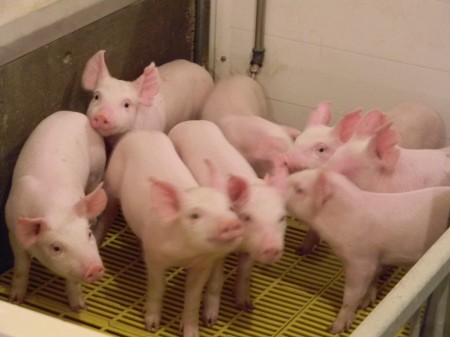
Farrowing –Sows are moved into the farrowing pens when they are late in the gestation period ( a few days away from birth). They give birth in the farrowing pens, which are equipped with gates that prevent them from rolling over on the piglets. At one time all pigs were induced so they would give birth during the day, but now they don’t bother.  Workers just show up and see in the morning who was born the night before. Piglets nurse right away, and the piglets fight/jostle to establish a pecking order (this is why they clip their needle teeth). Each piglet returns to the same teat every time; smaller piglets get the last teats, which have less milk (leading to runts). A full litter of piglets is 10-15. Sows have 14-16 teats, so if they have more piglets those piglets need to be spread around to other sows. The piglets nurse for 3weeks (4 at Prairie swine) and then are weaned.
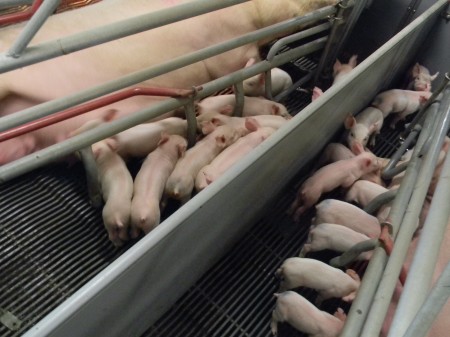
Nursery- weaner pigs come here to be separated from their sow at about 3- 4 weeks. These pigs get special high-grade, medicated food for the first 2 weeks, then move to regular adult food.
Grow/Finish- Pigs move here from the nursery to gain weight before going to market. They stay here until they are 4-5 months old (125kg). They are checked daily for health problems, but always have access to food and water.
Breeding-5 days after weaning, sows are ready to go into heat again. In the breeding room, a boar is driven around on a go cart to visit all the sows. This helps get the sows into heat, since they get to smell and see the boar so they know he’s around. Sows ears stand up and get flushed when they are in heat. Sows are artificially inseminated using boar semen from an offsite distributor. This looks like a tube of toothpaste that gets attached to a catheter and inserted into the sow. There is no squeezing – contractions in the sow’s uterus suck in the semen on its own in about 10 minutes, but only with the right ‘stimulation’: pressing on the sows back to simulate a boar, and having the boar nearby. In some barns they don’t have enough time to give every sow a backrub, so they have a heavy sand-filled saddle that they place on the sow during insemination. It can take 4-5 doses before a sow is pregnant. They keep the sows for 23 days and then ultrasound them. If there are no piglets, they try again. Sows can have up to 6 litters, then they are done and go to market themselves (usually as lunch meat since the meat quality is not as delicious on an older sow).
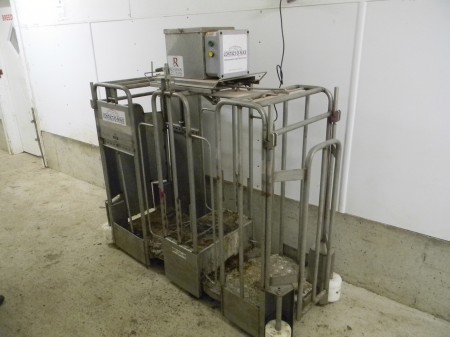
Gestation- Once the sows are pregnant, they go to a different room with their own feeding station and pen. At Prairie swine they can leave and go mingle with others if they like, but they usually don’t since some pigs are bullies. The gestation period for pigs is 114 days (almost 4 months). They get a set amount of food each morning from an automatic feeder, and water on demand.
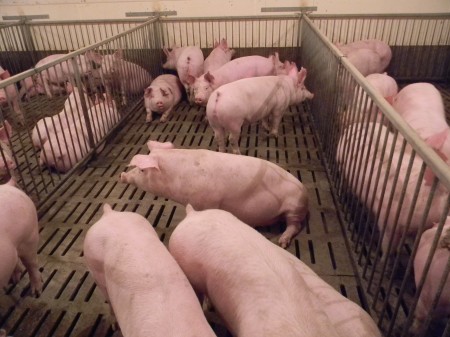
Selection of Gilts and Boars – At Prairie Swine there are 2 sows that are bred solely for herd replacement. Out of 2 litters each year, hope to get 6 good replacement sows. Female pigs that have not been bred are called ‘gilts’ and there is quite a beauty pageant to select the next set of breeding sows from the gilts. Promising gilts have 14 teats or more so they can foster lots of piglets, they are large and healthy, and they have very sturdy, healthy legs and feet so they can get around and support the 350kg of an adult pregnant sow.
Market day- This is when the pigs ‘go to market’ which is the industry euphemism for transport to the abbatoir. Every 1-2weeks, about 160 pigs leave the barn at one time. Pigs are selected for market once they reach 125kg – they are weighed every 2 weeks to see if they reach this weight. There are no large-scale abbatoirs in SK, so apart from small specialty producers, all Sask pigs go to Maple Leaf in Brandon or Olymel in Alberta.
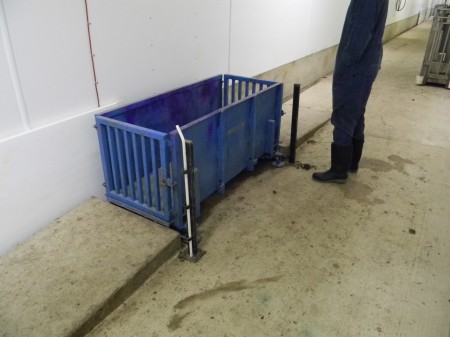

Great post! I didn’t (don’t?) know much about pig farming but this is a good start for me… I definitely feel a little better about my pork ribs now!